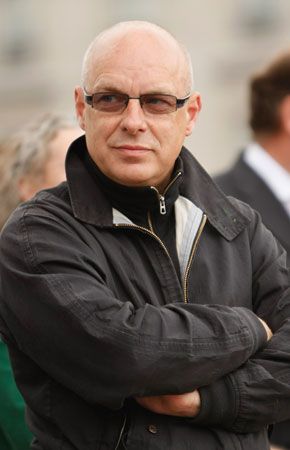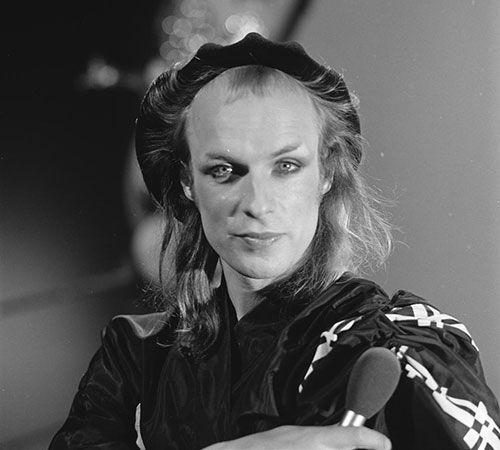Brian Eno
Our editors will review what you’ve submitted and determine whether to revise the article.
- In full:
- Brian Peter George St. John le Baptiste de la Salle Eno
- Born:
- May 15, 1948, Woodbridge, Suffolk, England
- Also Known As:
- Brian Peter George St. John le Baptiste de la Salle Eno
- On the Web:
- NPR - Roger And Brian Eno Reveal How They Made Their Tranquil New Album Together (Oct. 24, 2024)
Brian Eno (born May 15, 1948, Woodbridge, Suffolk, England) is a British producer, composer, keyboardist, and singer who helped define and reinvent the sound of some of the most popular bands of the 1980s and ’90s and who created the genre of ambient music.
While an art student in the late 1960s, Eno began experimenting with electronic music, and in 1971 he joined the fledgling band Roxy Music as keyboardist and technical adviser. A rivalry with singer Bryan Ferry led Eno to leave the group in 1973, whereupon he launched a solo career. No Pussyfooting (1973), a collaboration with guitarist Robert Fripp from King Crimson, used tape-echo and tape-delay techniques to create new sounds and reached the Top 30 in Britain. Eno’s next album, Here Come the Warm Jets (1973), was soon followed by the proto-punk single “Seven Deadly Finns.” In the mid-1970s Eno began developing his theory of ambient music, creating subtle instrumentals to affect mood through sound. Albums such as Discrete Music (1975), Music for Films (1978), and Music for Airports (1979) exemplified this approach.
During this period Eno also began producing albums for other artists, and his experimental approach to music making was well suited to such alternative performers as Devo, Ultravox, and David Bowie (especially on Bowie’s trilogy of albums recorded primarily in Berlin). Although Eno’s work was influential, it was not until his collaborations with Talking Heads and U2 that mainstream listeners became familiar with his sound, most notably on Talking Heads’ Top 20 album Remain in Light (1980) and U2’s chart-topping albums Unforgettable Fire (1984), The Joshua Tree (1987), and Achtung Baby (1991).
Throughout the 1990s, Eno joined a number of visual artists to provide sound tracks to installation pieces, and in 1995 he worked with Laurie Anderson on Self Storage, a series of installations housed in individual lockers at a London storage facility. Anderson provided the vocals for a track on Eno’s electronic album Drawn from Life (2000), and Eno followed with a rare vocal album of his own, Another Day on Earth (2005). He returned to the producer’s chair for Paul Simon’s critically lauded Surprise (2006) and Coldplay’s multi-platinum Viva la Vida (2008).
In 2008 Eno teamed with former Talking Heads frontman David Byrne for their first collaborative effort in nearly three decades. Adopting the self-publishing model popularized by Radiohead, Byrne and Eno released Everything That Happens Will Happen Today on the Internet, where listeners could stream the entire album for free or purchase physical or digital copies directly from the artists. Also in 2008 Eno and Peter Chilvers debuted the first of several smartphone apps that allowed the user to create generative music. Eno later collaborated with Karl Hyde of the British electronic band Underworld for the Afrobeat-inspired Someday World and the more accessible High Life (both in 2014) and with pianist Tom Rogerson on Finding Shore (2017). Among Eno’s own albums, the four-track The Ship (2016) meditated on the sinking of the Titanic and on World War I. In 2018 he released a box set of music commissioned for art pieces, Music for Installations. He collaborated with his brother, Roger Eno, on Mixing Colours (2020), a set of tone poems. He also released Film Music 1967–2020, a collection of his songs that had been used in movies and on television.
















